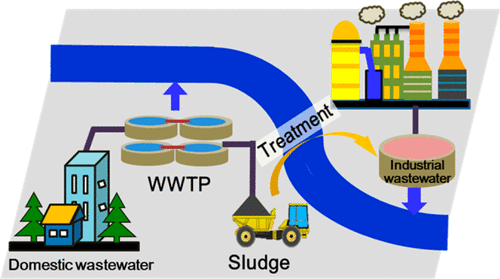当前位置:
X-MOL 学术
›
ACS Sustain. Chem. Eng.
›
论文详情
Our official English website, www.x-mol.net, welcomes your
feedback! (Note: you will need to create a separate account there.)
Electrochemically Catalytic Degradation of Phenol with Hydrogen Peroxide in Situ Generated and Activated by a Municipal Sludge-Derived Catalyst
ACS Sustainable Chemistry & Engineering ( IF 7.1 ) Pub Date : 2018-03-19 00:00:00 , DOI: 10.1021/acssuschemeng.8b00416 Bao-Cheng Huang 1 , Jun Jiang 1 , Wei-Kang Wang 1 , Wen-Wei Li 1 , Feng Zhang 1 , Hong Jiang 1 , Han-Qing Yu 1
ACS Sustainable Chemistry & Engineering ( IF 7.1 ) Pub Date : 2018-03-19 00:00:00 , DOI: 10.1021/acssuschemeng.8b00416 Bao-Cheng Huang 1 , Jun Jiang 1 , Wei-Kang Wang 1 , Wen-Wei Li 1 , Feng Zhang 1 , Hong Jiang 1 , Han-Qing Yu 1
Affiliation

|
With the rapid global urbanization, today’s cities are facing an increasing pressure for the treatment of both domestic and industrial wastewaters. In this work, a proof-of-concept of “treating industrial wastewater using the sludge originating from domestic wastewater treatment for urban pollution control” was proposed. After one-step pyrolysis of the excess sludge from domestic wastewater treatment, a metal–carbon composite catalyst with a high H2O2-producing capacity (432 mg/h/g) was successfully synthesized. By application of the prepared material as a cathode catalyst in an electro-Fenton system, phenol (40 mg/L), a model pollutant in industrial wastewaters, was completely degraded within 40 min at a potential of 0.15–0.35 V (vs reversible hydrogen electrode) without dosing external iron. Meanwhile, approximately 60% of total organic carbon was efficiently removed by the electro-Fenton system within 4 h at 0.25 V, and the hydroxyl radicals were found to be the main oxidation agent for the phenol degradation. More importantly, the phenol removal efficiency remained at a high level (87%) and the released iron was low (0.8 mg/L) even after 10 cycles of reuse. Thus, an efficient and cost-effective integrated system for the treatment of both domestic and industrial wastewaters was successfully developed and validated. The results from this work are useful to establish a new sustainable pollution control scenario.
中文翻译:

市政污泥衍生催化剂原位生成和活化的过氧化氢对苯酚的电化学催化降解
随着全球城市化的迅速发展,当今的城市在处理生活和工业废水方面面临越来越大的压力。在这项工作中,提出了“使用生活污水处理产生的污泥处理工业废水以控制城市污染”的概念证明。对生活污水处理后的剩余污泥进行一步热解后,即可得到具有高H 2 O 2的金属-碳复合催化剂成功地合成了生产能力(432 mg / h / g)。通过将制得的材料用作电子芬顿系统中的阴极催化剂,工业废水中的典型污染物苯酚(40 mg / L)在0.15–0.35 V(相对于可逆氢)的电势下在40分钟内被完全降解。电极)而无需添加外部铁。同时,通过电子芬顿体系在0.25 V下4小时内有效去除了约60%的总有机碳,并且发现羟基自由基是苯酚降解的主要氧化剂。更重要的是,即使重复使用10个循环,苯酚的去除效率仍保持较高水平(87%),释放的铁较低(0.8 mg / L)。因此,成功开发并验证了一种用于处理生活和工业废水的高效,经济高效的集成系统。这项工作的结果对于建立新的可持续污染控制方案很有用。
更新日期:2018-03-19
中文翻译:

市政污泥衍生催化剂原位生成和活化的过氧化氢对苯酚的电化学催化降解
随着全球城市化的迅速发展,当今的城市在处理生活和工业废水方面面临越来越大的压力。在这项工作中,提出了“使用生活污水处理产生的污泥处理工业废水以控制城市污染”的概念证明。对生活污水处理后的剩余污泥进行一步热解后,即可得到具有高H 2 O 2的金属-碳复合催化剂成功地合成了生产能力(432 mg / h / g)。通过将制得的材料用作电子芬顿系统中的阴极催化剂,工业废水中的典型污染物苯酚(40 mg / L)在0.15–0.35 V(相对于可逆氢)的电势下在40分钟内被完全降解。电极)而无需添加外部铁。同时,通过电子芬顿体系在0.25 V下4小时内有效去除了约60%的总有机碳,并且发现羟基自由基是苯酚降解的主要氧化剂。更重要的是,即使重复使用10个循环,苯酚的去除效率仍保持较高水平(87%),释放的铁较低(0.8 mg / L)。因此,成功开发并验证了一种用于处理生活和工业废水的高效,经济高效的集成系统。这项工作的结果对于建立新的可持续污染控制方案很有用。











































 京公网安备 11010802027423号
京公网安备 11010802027423号